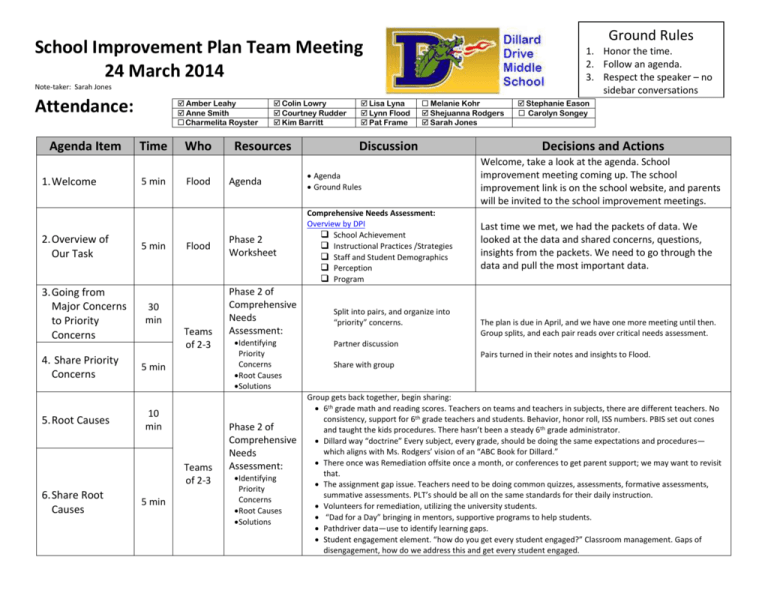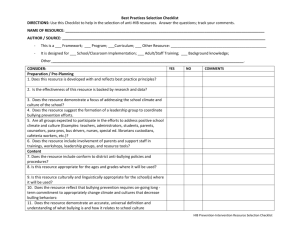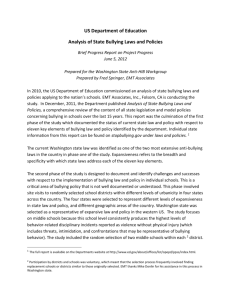3/24/14 - Dillard Drive Middle School
advertisement

Ground Rules School Improvement Plan Team Meeting 24 March 2014 1. Honor the time. 2. Follow an agenda. 3. Respect the speaker – no sidebar conversations Note-taker: Sarah Jones Attendance: Agenda Item 1. Welcome 2. Overview of Our Task 3. Going from Major Concerns to Priority Concerns 4. Share Priority Concerns 5. Root Causes Amber Leahy Anne Smith Charmelita Royster Time 5 min 5 min Who Flood Flood 30 min Teams of 2-3 5 min 10 min Teams of 2-3 6. Share Root Causes 5 min Colin Lowry Courtney Rudder Kim Barritt Resources Lisa Lyna Lynn Flood Pat Frame Melanie Kohr Shejuanna Rodgers Sarah Jones Discussion Stephanie Eason Carolyn Songey Decisions and Actions Agenda Agenda Ground Rules Welcome, take a look at the agenda. School improvement meeting coming up. The school improvement link is on the school website, and parents will be invited to the school improvement meetings. Phase 2 Worksheet Comprehensive Needs Assessment: Overview by DPI School Achievement Instructional Practices /Strategies Staff and Student Demographics Perception Program Last time we met, we had the packets of data. We looked at the data and shared concerns, questions, insights from the packets. We need to go through the data and pull the most important data. Phase 2 of Comprehensive Needs Assessment: Identifying Priority Concerns Root Causes Solutions Phase 2 of Comprehensive Needs Assessment: Identifying Priority Concerns Root Causes Solutions Split into pairs, and organize into “priority” concerns. The plan is due in April, and we have one more meeting until then. Group splits, and each pair reads over critical needs assessment. Partner discussion Pairs turned in their notes and insights to Flood. Share with group Group gets back together, begin sharing: 6th grade math and reading scores. Teachers on teams and teachers in subjects, there are different teachers. No consistency, support for 6th grade teachers and students. Behavior, honor roll, ISS numbers. PBIS set out cones and taught the kids procedures. There hasn’t been a steady 6th grade administrator. Dillard way “doctrine” Every subject, every grade, should be doing the same expectations and procedures— which aligns with Ms. Rodgers’ vision of an “ABC Book for Dillard.” There once was Remediation offsite once a month, or conferences to get parent support; we may want to revisit that. The assignment gap issue. Teachers need to be doing common quizzes, assessments, formative assessments, summative assessments. PLT’s should be all on the same standards for their daily instruction. Volunteers for remediation, utilizing the university students. “Dad for a Day” bringing in mentors, supportive programs to help students. Pathdriver data—use to identify learning gaps. Student engagement element. “how do you get every student engaged?” Classroom management. Gaps of disengagement, how do we address this and get every student engaged. Agenda Item Time Who Resources Discussion Decisions and Actions Accountability of how to get students to be engaged, but how do you get the students to complete assignments and show what they know, can and do. Sharing best practices, department meeting plans, professional development plans. New teacher support, asking for help, collaboration. All teachers need to get to know each other, and work together so everyone is comfortable to collaborate on a regular basis. Half day collaboration with other teachers. Being able to have that time to bond and work together. Bullying is a word that can be thrown around. Teasing and bullying are different, and the term is a “buzz” word. The survey form asks the students if they think bullying is a problem. Students need to know what bullying really is. Consistency Differentiation, teachers feeling as though they do not have enough time to meet every student needs. Connection, positive teacher/student relationship 7. Our next meeting 1 min Flood Monday, April 28th 3:30 Media Center Our Quarterly Review is due May 2nd. Royster, Rudder, Eason, and Lowry~please begin to gather your data! Last thoughts from Rodgers: 8. Review Next Steps 10 min S. Jones Minutes Classroom management plans, team plans, grade level plans. Preventative measures Teaching students how to behave You earn it, you get it. For the future: 4 days to meet in small groups for professional development. Encourage to come for the day, and then swap out another day. Need good strong start, and good collaborative start. High standards and high expectations= greatness. Students, staff, and admin, community What does greatness look like? Everyone should be willing to grow and be lifelong learners. Being professional and we are all going to grow. Book Clubs, articles. Great teachers! Performance gap between subgroups Asian scores (Asians had 52.8% proficiency compared to 73% in the district) Multi-risk students at all grade levels Hispanic scores Strengthening internal classroom management to try to engage subgroups Sixth grade reading and math scores are low in comparison to the district and to other grade levels 6th grade—high expectations, rigor, and skill instruction Raising accountability for low performing teachers to attend PD opportunities Making time for teachers with low assessment data to observe and learn from teachers with high assessment data Over 100 students in each grade level did not pass 3rd grade Reading and Math EOGs; 3rd grade data has been correlated to ongoing proficiency and graduation rates. DDMS Reading: 48% District Reading: 54% DDMS Math: 39% District Math: 54% For Honor Roll celebrations, there are over 500 students recognized for academic achievement and fewer than 50 are African-American or Hispanic. Lessons for Dillard Drive MS From Learning Focused: Instructional strategies, practices, activities, and decisions have to become more consistent as a school’s percentage of students who qualify for Free/Reduced Meals increases. DDMS’ F&R population has increased Staff Demographics BTs increased from 13% to 21%. Losing 4-10 year people, but keeping 10+ years. Student Demographics: Have changed over the years: EOG data-over a period of 3 years we went from 25% of students receiving a 1 or a 2, it has gone down to 21% With the student reassignment, we lost about 125 AIG students. Students that are classified as SPED went from 13% to 31%. % of LEP students has increased % of F&R students has increased from 38%-45.1% Program Perception Instructional ractices / Strategies Concerns Staff and Student Demographics SIP Area School Achievement Critical Needs Assessment from 38.4% to 45.1% over the past three years. The Assignment Gap is the difference between standards (what students should be able to know, understand, and do) and what they are being taught and assigned. Students can only do as well, or learn, as the instruction and assignments they receive. The consequences of the Assignment Gap are devastating for student achievement and school success. There is evidence of an assignment gap based on observations of instruction and student performance. Student Survey-372 7th graders were surveyed here compared to other schools. Very consistent data with the district data. Only 14% of students say that they don’t feel safe. That is consistent with other schools in the county. 1/3 of kids feel that they cannot talk to an adult. ½ think that bullying is problem. Looked into definition of what bullying is. 50% of kids do see and find that as an issue. Teacher Working Conditions Survey Teachers feel that they do not have enough time to meet every need of every student. Teachers feel that the community knows what is going on, but they are not there to support teachers Teachers feel that admin supports teachers, but students are not following the rules Regarding ISS and OSS: Over the course of 400 referrals, fewer than 10 cases involved white students. The other 97% involved African-American and Hispanic students. The percentage of ethnicities is approximately: Black: 31% Hispanic: 19% Multi-racial: 4% White: 43% For universal screeners, we have PathDriver and iReady but data is only used on-team to identify remediation needs. For remediation, we have Academy of Reading, VMath, SuccessMaker. Class sizes are small and have room for more students. We offer after-school math tutoring; 1 tutor several days a week who provides remediation for all three grade levels. We provide ALC for <10 students for a 45 day duration. Priority Concerns Root Causes Solutions Based on our discussion as a SIP team, there are themes that permeate the data which include: Raising student achievement for subgroups Consistent and rigorous standardsbased instruction Clear communication and teaching of discipline expectations Support for students in terms of mentoring and academic support Building a sense of community and trust among teachers to enhance collaboration.







